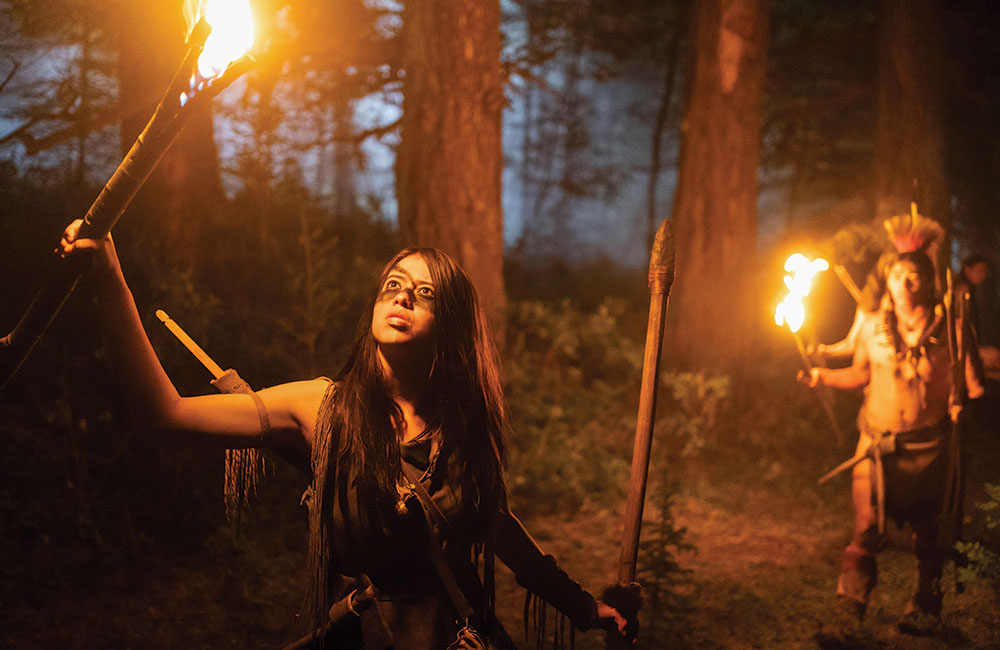
Courtesy of David Bukach/ 20th Century Studios

Despite the month-long training for tomahawk fight sequences and wading through glacial Albertan river waters in traditional buckskin, for Amber Midthunder, a good gauge of the commitment to onscreen accuracy of Indigenous lives in the late 1700s in the new film Prey came down to how her character would brush her teeth.
“Dan [Trachtenberg, the film’s director] at one point said, ‘Did people brush their teeth [back then]? Like how did that work?’ ” recalls the actress. Luckily, Prey producer Jhane Myers, a member of the Comanche Nation, provided the production with thick binders of reference materials and research and knew how to make a period-accurate toothbrush, which Midthunder can be seen using onscreen. This level of dedication is particularly notable given the fact that Prey isn’t a hyperrealistic period drama in the vein of The Revenant — it’s the fifth installment in the Predator franchise.
Out Aug. 5 via 20th Century Studios and Hulu, Prey follows Naru, a young Comanche woman trying to prove herself as a hunter when she is pitted against an alien with an endless desire to hunt. Midthunder’s character collects medicine, cooks, and handles other domestic concerns in between fight sequences with a massive humanoid extraterrestrial with otherworldly strength and fluorescent bodily fluids. “I have been very intentional about not doing a lot of like Indigenous specific roles,” notes the actress, an enrolled tribal member of the Fort Peck Assiniboine and Sioux Tribe. She notes that with period stories “you very rarely get good representation. Good being accurate, respectful or something to be proud about.” If a Predator movie could ever possibly be described as “authentic” or “grounded”, this would be the one, with Midthunder’s performance being the anchor.
Growing up in New Mexico just as it was becoming a bustling production hub, the 25-year-old has long been entertainment-adjacent. Her mother, Angelique, is a veteran, Emmy-nominated casting director, and her father, David, is a veteran actor known for his roles in Longmire and Westworld. But, she explains, “We really don’t, as a family, take work home.”

Courtesy of David Bukach/ 20th Century Studios
Midthunder was slow to warm to the idea of acting as a career — at one point she considered becoming a professional MMA fighter — despite having grown up memorizing the lines from her father’s auditions. Finally committing to acting, she moved to Los Angeles when she was 17 with the hope for a career with Jennifer Lawrence-style levels of variety: “The dream for any actor is really the ability to choose what space you take up.”
But prospective reps had other ideas. “[Agencies] were like, “Okay, you can go on the Disney Channel.’ And I was like, ‘No, no, no. That is a skill for a lot of people, but that’s not a skill that I have. I want to cry. I want to feel horrible things through my art. I want to suffer!’ And they were like, ‘That’s cute. Go do Disney,’” she laughs. And the learning curve from the entertainment industry in New Mexico to Hollywood proved a challenge: “It felt like going from playing in your backyard to doing something in front of people for real, with real stakes and real consequences.”
But Midthunder did manage to stay out of the tween television trenches, instead booking roles on Noah Hawley’s beloved X-Men series Legion, CW series Roswell: New Mexico, and in the Liam Neeson movie The Ice Road. Prey marks her first starring role.
During her first rounds of auditions with Trachtenberg, best known for 10 Cloverfield Lane, Midthunder didn’t know she was reading for a Predator film. With only a handful of script pages for context, she assumed the movie was a period drama, a genre she has purposely avoided because of Hollywood’s abysmal track record with Indigenous portrayals onscreen. She notes, “You very rarely get good representation — good being accurate, respectful or something to be proud about.”
It wasn’t until the camera test that Midthunder received the full script and realized what the movie was and what it would represent: “This is the first time you get to see an Indigenous female action hero at the center of a film. That in and of itself is a really incredible statement.”
This story first appeared in the Aug. 3 issue of The Hollywood Reporter magazine. Click here to subscribe.